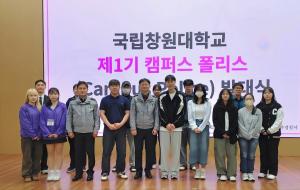 |
| ▲ At lunchtime, the Sarimgwan Cafeteria was filled with students |
Due to the easing of COVID- 19 sanctions, most of the classes have been conducted as face- to- face classes since the beginning of this semester. At lunchtime, you can see long lines of students at the school cafeteria to buy food tickets. After the face- to- face class conversion, students have to find 'lunch' during the time in- between classes. We asked our school students through a survey on how they solve what to choose for lunch during the time in-between classes.
The survey respondents were 159 students from CWNU. 'Off- campus restaurants (42.8%)' and 'on- campus restaurants (35.2%)' were the most preferred ways to determine what to have for lunch, in in- between classes time. The rest preferred 'convenience stores (10.1%)' and 'others (11.9%),’ students who do not use restaurants answered that they simply eat at convenience stores or order delivery to their departmental common rooms. The most preferred restaurant on- campus is Sarimgwan (62.9%). Most of the students who preferred Sarimgwan (79%) answered that they preferred it because it was, "closer and more delicious." Students who preferred Bongrimgwan (23.3%) answered that they preferred it because it was, "closer and cheaper," (102%). Based on the figure of 102%, it seems that some students use Bongrimgwan because it is closer and cheaper, even if they don't prefer it the most. Sarimgwan is located close to the College of Engineering and the College of Humanities (currently Hall 98), and Bongrimgwan is located close to the College of Business Administration, the College of Social Sciences, and the College of Natural Sciences. Students who use the school cafeteria during their in- between class times, are determining where they purchase their lunch, in consideration of the location of their classroom.
Among the students who use the school cafeteria, 13.8% of them prefer 'dormitory restaurants.' Dormitory restaurants can only be used by students living in the dormitory. Dormitory restaurants are quite far apart, except for Business Administration and Social Science colleges, so the travel time is long when using dormitory restaurants. Nevertheless, students who use dormitory restaurants responded that they use it because it is more, 'economical and to stop by the dormitory because in-between classes time is ambiguous,' (224%). The 224% figure shows that students who do not prefer dormitories also use dormitory restaurants for the above stated reasons. The dormitory fee includes a minimum of 0.5 of the meals' fee. Many students decided that it was economical to solve the mystery of their lunches at a dormitory restaurant because they have already purchased them.
The improvement point of the school cafeteria is 'taste (35.8%),’ 'price (17.7%),' 'enough seating arrangements (12.1%),' 'food distribution cycle activation (12.1%),' 'other (9.1%),' 'sanitation management (7.5%),' and menu fixation (4.5%). Most of the students who chose 'other' were asked to move up or increase the existing operating hours of the school cafeteria (from 11:30 a.m. to 2 p.m.). When students suddenly flock at lunchtime, if the pre-prepared menu drops, the cafeteria should start re-cooking. During re-cooking, a waiting time of about 10 to 20 minutes occurs. Due to the fact that the waiting line and the pre-cooking time are both long, students who are waiting in the back of the line, wait for a long time. In fact, at lunch time, cafeteria attendants and students seemed flustered at the CWNU cafeteria. Also, students who receive food are caught off guard because there are no seats. In particular, there are students who leave their seats with bags and belongings before they line up because there are too many people in Sarimgwan Cafeteria. Some students go back in surprise when they see the number of people while trying to eat. Sanitary management is also a problem during meals because there is no time to wipe away food spilled on the table or floor due to the large number of people.
At lunchtime, students first consider the nearest school cafeteria to solve the origin of their meals, according to their time in- between classes. As the school cafeteria is in charge of lunch for our school students, the school cafeteria should try to make sure that students eat efficiently during the in- between class time. Not only cafeterias, but also convenience store rest areas, outdoor benches, and classrooms where students eat should be cared for, so that hygiene is maintained. As CWNU's campus is revitalized, we hope all members of CWNU tend to that everyone can enjoy our lunch time as a university culture.
By Kim Su-gyung, cub-reporter tnrud2824@naver.com
<저작권자 © The Campus Journal, 무단 전재 및 재배포 금지>

 Shrinkflation, Consumer Deception
Shrinkflation, Consumer Deception




